ikfoundation.org
Promoting Natural & Cultural History
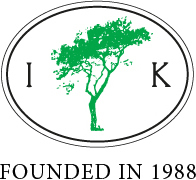


ESSAYS |
VICTORIAN FASHION
– in a Museum Collection
The comprehensive Whitby Museum collection related to clothing is unique in many ways for a small town, especially with its important collection of almost 200 dresses, dating from the Victorian period (1837-1901). My research methods and aims of this collection have mostly concentrated on such questions as choice of cloth, handicraft skill and details of stitching and tailoring comparison home-sewing, clothing for various purposes, the importance of accessories and sewing by hand or machine. Many garments cannot be accurately defined in terms of basic fashion terminology unless taking into account the influence of tradition, a woman’s age, the delay before new trends reached small towns, and aspects of religion, economic conditions and the many unwritten social rules that affected every woman’s choice to what she decided to wear.
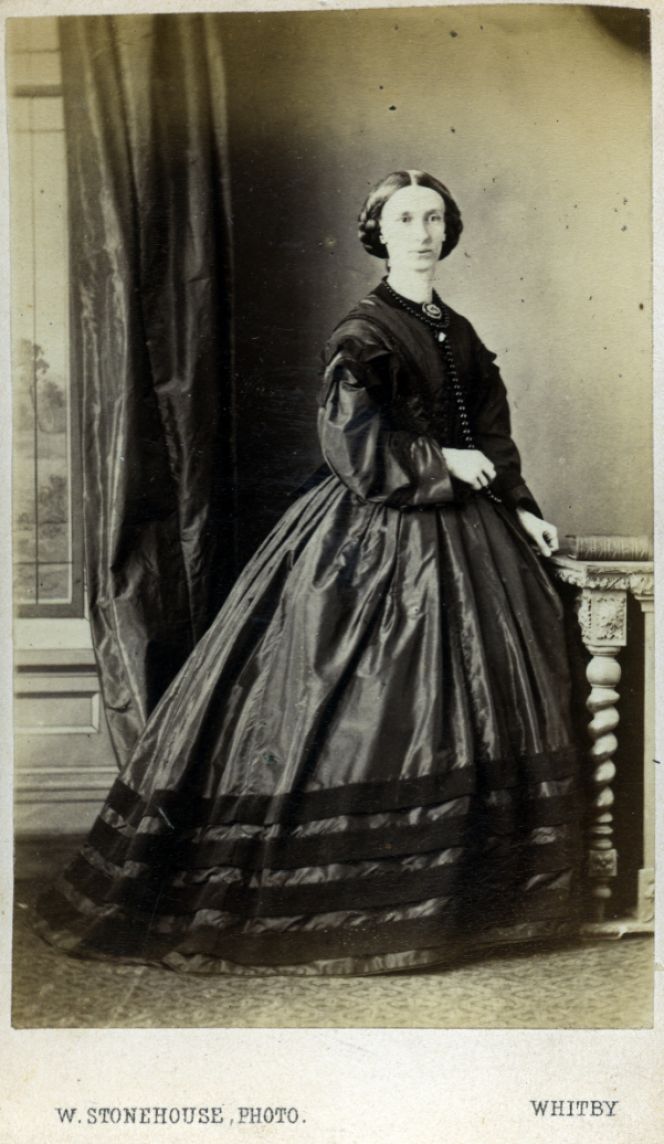 This lady is dressed in a dark coloured satin dress decorated with broad velvet ribbons. A sort of dress which requires a professional dressmaker’s hand to reach perfection in cut and sewing. The photograph is taken in 1866 by the photographer W. Stonehouse. The Pier Portrait Rooms in Whitby. Courtesy of: Whitby Literary & Philosophical Society, Whitby Museum, Photographic Collection.
This lady is dressed in a dark coloured satin dress decorated with broad velvet ribbons. A sort of dress which requires a professional dressmaker’s hand to reach perfection in cut and sewing. The photograph is taken in 1866 by the photographer W. Stonehouse. The Pier Portrait Rooms in Whitby. Courtesy of: Whitby Literary & Philosophical Society, Whitby Museum, Photographic Collection.A fair number of items in the collection were donated in the 20th century by ladies most likely descended from families with draper’s businesses in Whitby. Of these, ‘Mrs Frankland, Carr Hill Lane, Briggswath Whitby’ was probably connected with Frankland & Son of 88 Church Street, a draper’s shop that advertised in the Whitby Gazette during the 1860-1880 period. She gave a well-sewn skirt and bodice in striped blue silk (GBD19) from the early 1870s, with wide sleeve ends and decorated with blue and black silk details. Another lady who gave several items was ‘Miss G. Wellburn, Sleights’, whose name links her with the long-lived Wellburn Brothers Linen and Woollen Drapery Establishment in Bridge Street that advertised regularly between 1857 and 1901.
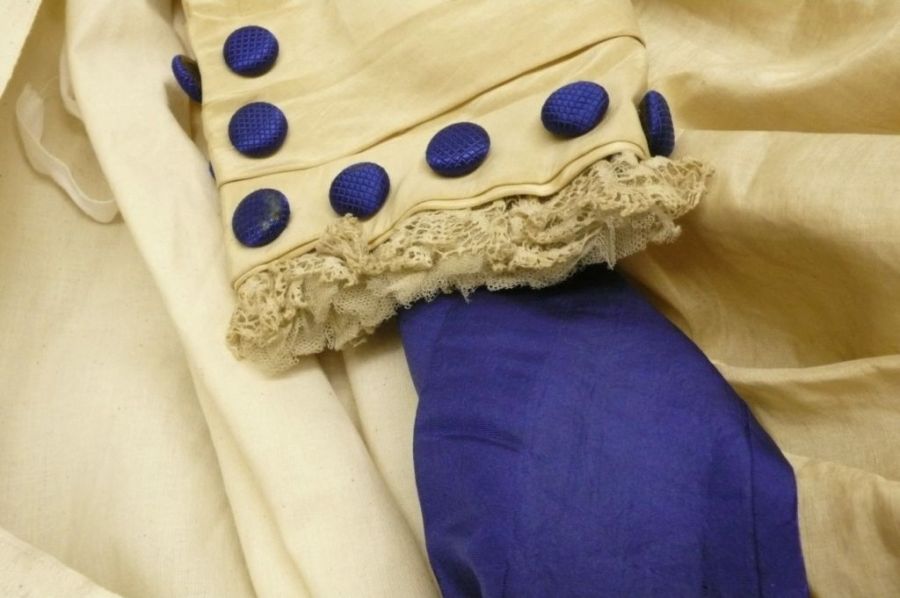 A third donor, ‘Mrs S. Gray, Carr Hill Sleights’, was related to ‘Robt Gray & Co. General Drapers 2 & 3 Old Market Place’ who in this period advertised between 1874 and 1901. From her came a beige silk dress from the 1890s (GBD20) decorated with blue silk ribbon and silk-covered buttons of the same colour with linen lace and unbleached tulle (Owner: Whitby Museum, Costume Collection) Photo: Viveka Hansen.
A third donor, ‘Mrs S. Gray, Carr Hill Sleights’, was related to ‘Robt Gray & Co. General Drapers 2 & 3 Old Market Place’ who in this period advertised between 1874 and 1901. From her came a beige silk dress from the 1890s (GBD20) decorated with blue silk ribbon and silk-covered buttons of the same colour with linen lace and unbleached tulle (Owner: Whitby Museum, Costume Collection) Photo: Viveka Hansen.During the second year of Whitby Gazette Edmund Crane’s Linen and Woollen Drapers, apparently the largest such local firm in 1855, advertised continually (see image below). The shop had a rich stock to offer its customers, mainly clothing and accessories for clothes but also textiles for home furnishing. G.S. Breckon’s smaller advertisement from the same year was less comprehensive, but readers were informed that Breckon’s sold ‘Smith’s Patent Royal Symmetrical & Radion Corsets’. These corsets were most likely machine-sewn in view of their patent, although many corsets were still hand-sewn in the mid-1850s. Thanks to the introduction of the sewing machine at the beginning of that decade, the production of underclothes and corsets developed into a substantial industry at a speed that would not have been possible with hand-sewing.
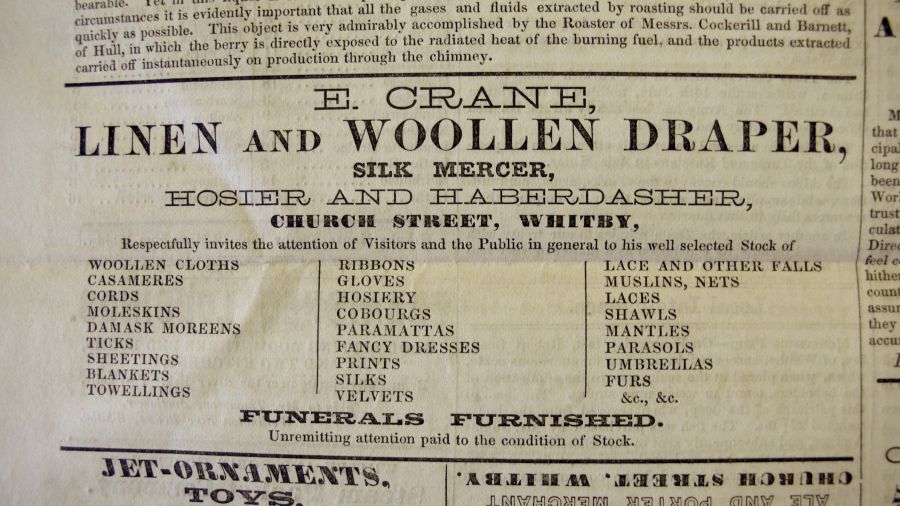 Advertisement in Whitby Gazette. On 27 July 1855 Crane’s listed the following material and ready-made goods (Owner: Whitby Museum, The Library). Photo: Viveka Hansen
Advertisement in Whitby Gazette. On 27 July 1855 Crane’s listed the following material and ready-made goods (Owner: Whitby Museum, The Library). Photo: Viveka Hansen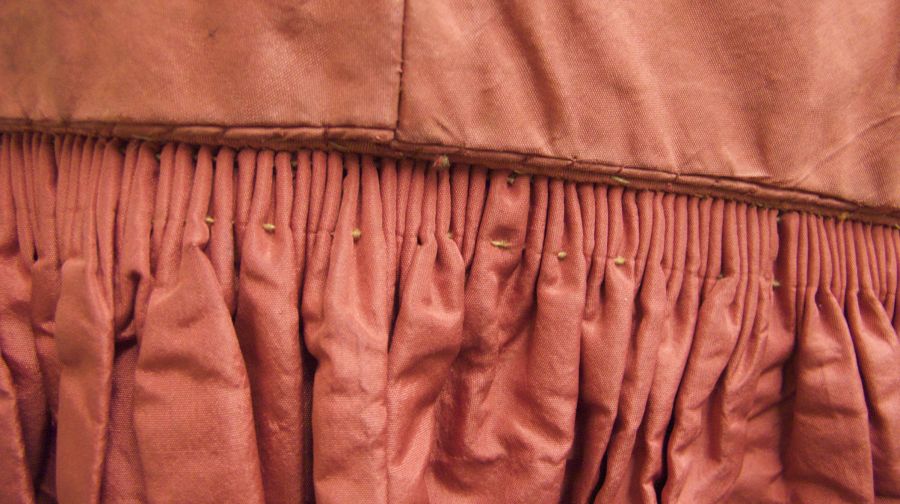 A dress from the Whitby Museum collection demonstrates how tight gatherings were prepared and sewn together with coarse linen thread in this hand-sewn silk dress, dating mid to late 1850s. In general, drawing together considerable width in tight pleats of this kind especially in the back half of the skirt had long been a custom in England as in other countries. This was an unsurpassed design detail when it was necessary to draw together a skirt 3 or 4 metres in circumference in the smartest possible way. Red silk fabric dress c. 1855-60. (Owner: Whitby Museum, Costume Collection, GBD 13). Photo: Viveka Hansen.
A dress from the Whitby Museum collection demonstrates how tight gatherings were prepared and sewn together with coarse linen thread in this hand-sewn silk dress, dating mid to late 1850s. In general, drawing together considerable width in tight pleats of this kind especially in the back half of the skirt had long been a custom in England as in other countries. This was an unsurpassed design detail when it was necessary to draw together a skirt 3 or 4 metres in circumference in the smartest possible way. Red silk fabric dress c. 1855-60. (Owner: Whitby Museum, Costume Collection, GBD 13). Photo: Viveka Hansen.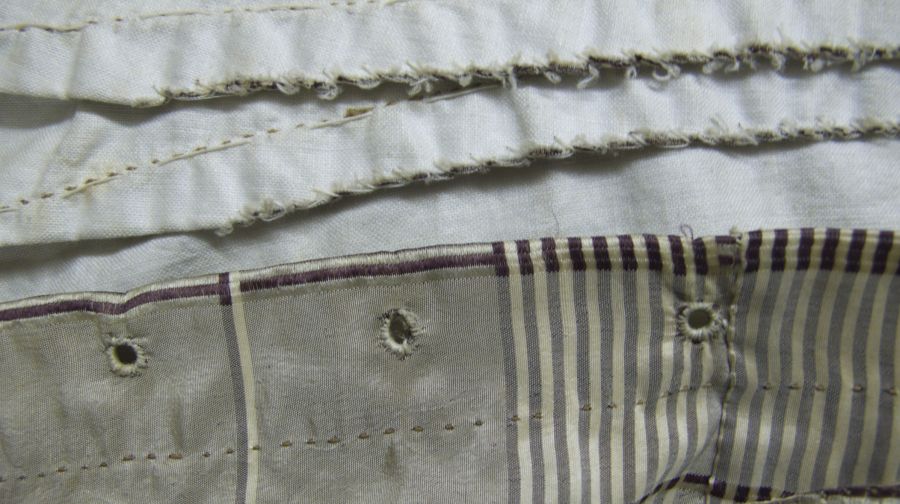 A second detailed example from the Whitby Collection is this dress of checked silk fabric, dating to the late 1840s. Every part of this garment has been sewn by hand and much of the work would unquestionably require an experienced dressmaker, especially the link between skirt and bodice with its many complicated features, as is also the case with the separate bodice in general. On the other hand, the many long seams of running stitches in the skirt may well have been done by a girl apprentice or sent out to a seamstress specialising in this kind of simpler seam work. This detail of the dress in a ribbed silk quality in brown, grey and white displays running stitches and slip-stitching as well as still having some of the seamstress’s longer tacking stitches in place. At the same time there are carefully sewn holes at regular intervals, to fit corresponding hooks on the other side of the bodice. (Owner: Whitby Museum, Costume Collection, 2006/42.13). Photo: Viveka Hansen.
A second detailed example from the Whitby Collection is this dress of checked silk fabric, dating to the late 1840s. Every part of this garment has been sewn by hand and much of the work would unquestionably require an experienced dressmaker, especially the link between skirt and bodice with its many complicated features, as is also the case with the separate bodice in general. On the other hand, the many long seams of running stitches in the skirt may well have been done by a girl apprentice or sent out to a seamstress specialising in this kind of simpler seam work. This detail of the dress in a ribbed silk quality in brown, grey and white displays running stitches and slip-stitching as well as still having some of the seamstress’s longer tacking stitches in place. At the same time there are carefully sewn holes at regular intervals, to fit corresponding hooks on the other side of the bodice. (Owner: Whitby Museum, Costume Collection, 2006/42.13). Photo: Viveka Hansen.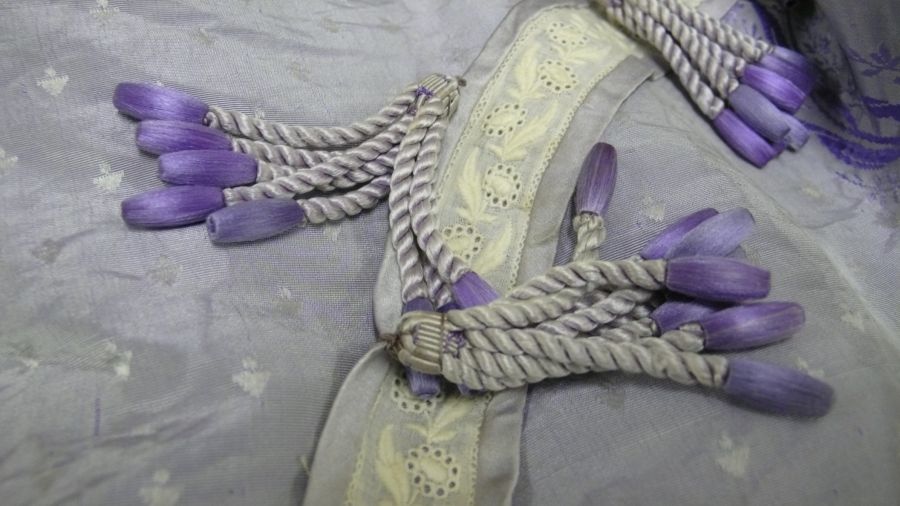 A third close-up study of a well preserved silk brocade dress in the Whitby collection, dating from the early 1870s. The upper part of this dress shows curtain-like decorations characteristic of the period, here in the form of twisted silk tassels fastened to machine-embroidered lace. The dress – separate bodice and the skirt – are mainly machine-made with minor hand-sewn details. Whilst, the usual hooks and eyes for holding the bodice together have been replaced by thread buttons and corresponding buttonholes on this silk brocade dress. (Owner: Whitby Museum, Costume Collection, 2006/42.17). Photo: Viveka Hansen.
A third close-up study of a well preserved silk brocade dress in the Whitby collection, dating from the early 1870s. The upper part of this dress shows curtain-like decorations characteristic of the period, here in the form of twisted silk tassels fastened to machine-embroidered lace. The dress – separate bodice and the skirt – are mainly machine-made with minor hand-sewn details. Whilst, the usual hooks and eyes for holding the bodice together have been replaced by thread buttons and corresponding buttonholes on this silk brocade dress. (Owner: Whitby Museum, Costume Collection, 2006/42.17). Photo: Viveka Hansen.To explain further the choice of facts in my research, it has not been possible to localise the origin of the woven or printed material used in the manufacture of clothes – like in such dresses, illustrated above. Close studies of books of samples etc relating to the myriad of businesses involved in both the weaving and printing of cloth is virtually impossible during this period when no clues survive as to either specific regions or individual manufacturers. Especially if one bears in mind that many of the more exclusive qualities of material were imported from abroad for the British market.
Sources:
- Hansen, Viveka, The Textile History of Whitby 1700-1914, Whitby & London 2015 (research material, pre-publishing, Ch. V).
- Whitby Gazette 1855-1901 (Whitby Museum Library & Archive).
- Whitby Museum, Costume Collection (studies of Victorian garments).
Essays
The iTEXTILIS is a division of The IK Workshop Society - a global and unique forum for all those interested in Natural & Cultural History from a Textile Perspective.
Open Access essays - under a Creative Commons license and free for everyone to read - by Textile historian Viveka Hansen aiming to combine her current research and printed monographs with previous projects dating back to the late 1980s. Some essays also include unique archive material originally published in other languages, made available for the first time in English, opening up historical studies previously little known outside the north European countries. Together with other branches of her work; considering textile trade, material culture, cloth manufacturing, fashion, natural dyeing and the fascinating world of early travelling naturalists – like the "Linnaean network" – from a Global history perspective.
For regular updates, and to make full use of iTEXTILIS' possibilities, we recommend fellowship by subscribing to our monthly newsletter iMESSENGER.
been copied to your clipboard




– a truly European organisation since 1988
Legal issues | Forget me | and much more...
It is free to use the information/knowledge in The IK Workshop Society so long as you follow a few rules.
 LEARN MORE
LEARN MORE








